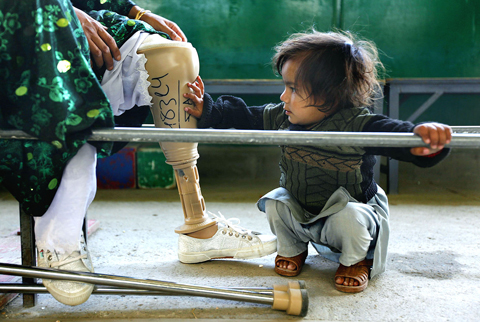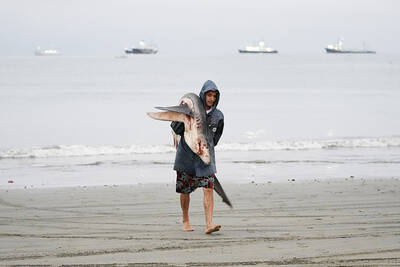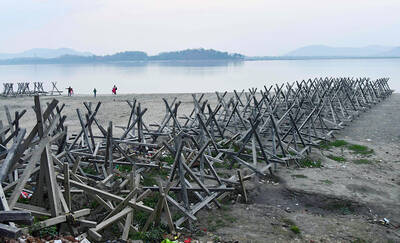Moussa Khan had just been making his way back from a long day’s work at a copper mine south of Kabul thinking about the son he lost a week earlier to a landmine blast. That day, Khan too stepped on a landmine.
Seven months later, Khan, his lined face wrinkled in concentration, still struggles to find his balance with a prosthetic limb in place of his right leg.
“When I heard the bang, I suddenly found myself flung nine meters away. May God punish them all,” raved Khan, 50, his frail body clothed in a blue grayish traditional Afghan long shirt and baggy trousers.

PHOTO: REUTERS
Who planted the mine?
In Afghanistan, with its three decades of conflict, it could have been the “Russians, the Communists, the Taliban”, he said.
Last year alone, landmines caused 5,197 casualties worldwide, a third of them children, according to the International Campaign to Ban Landmines (ICBL).
Countries will gather in Cartagena, Colombia, from today to Friday for a major review conference of the ten-year-old Ottawa Mine Ban Treaty, which has been ratified by 156 states, the ICBL says.
Large countries such as the US, Russia, Pakistan and India have yet to sign up, but campaigners hope to persuade them.
Some 44 million stockpiled anti-personnel mines have been destroyed over the past decade by states under the treaty. But in Afghanistan, vast undetected areas remain covered in mines.
An orthopedic center run by the International Committee for the Red Cross in Kabul registered 842 amputees in the first 10 months of this year, three quarters of them victims of land mines.
The center provides prosthetic limbs and designs wheelchairs and crutches for disabled patients. Najmuddin Helal, head of the orthopedic center and a mine victim himself, said more than 90 percent of the employees are disabled.
“We call it discrimination, but positive discrimination,” he said.
Amputee employees, having been through the trauma of an accident and learning to live with an artificial limb can better relate to patients affected by a similar experience, he said.
“To lose part of the body is not easy to accept. When they [patients] come here of course they are so disappointed and they are depressed,” Helal said.
“In a way it helps them to see many other disabled here, who can get prostheses and can walk again. It’s a hope for them, to help them psychologically. They see that with a disability, life will not stop.”
The center, a sprawling maze of workshops, clinics and a gymnasium-like space for patients to test their prostheses, focuses a lot of work on social reintegration of its patients.
Amputee patients are encouraged to continue education, learn a trade or work at the centre if there is room for them.
The center offers a US$600 micro-loan to be paid over 18 months for patients who want to start their own business, such as selling goods in a shop. So far about 6,000 people have been the beneficiaries of that project.
“To find jobs for non-disabled people in Afghanistan is almost impossible, for the disabled it makes it worse,” Helal said.
Throughout Afghanistan’s tumultuous history, warring factions have changed and frontlines have shifted, leaving the country littered with landmines and little mapping system to locate them.
“To put the mine, it is very easy. But to clear them, is so difficult,” Helal said.
About 650km² of Afghanistan is still littered with mines, said Shahab Hakimi, head of Afghanistan’s Mine Detection Dog Center (MDC), which trains bomb-sniffing dogs and carries dangerous out mine clearance work.
It’s an area almost the size of New York City. Assuming security and funds are available, MDC could clear it in four to five years, Hakimi said.
In Tangi Sayedan village south of Kabul, a team of some 20 de-miners use mine-sensor tools and sniffer dogs to detect mines. It is dangerous, painstaking work. Between 30 and 35 MDC workers have been killed on the job and 25 permanently disabled.
The organization has dug up mines manufactured in places as far-flung as Egypt, Italy, Iran, India, Pakistan and Russia.
A 2009 Landmine Monitor Report says 160 million stockpiled anti-personnel mines remain, mainly in the stockpiles of five countries that have shunned the treaty — China, Russia, the US, Pakistan and India.
Teenager Nour Rahman does not know who planted the landmine he hit four months ago when driving a tractor. Hoisting his maimed leg towards the sun at the ICRC center and sporting a red leather jacket, Rahman says his life has not changed.
“I just lost a leg, otherwise I’m the same. I have a bright future,” said Rahman, who still dreams of being an engineer.
For Helal, Rahman’s optimism is the reason why he has been doing his job for so long. Helal himself lost both legs nearly 30 years ago, when he was 18 years old
Helal had just finished high school and was hoping he could attend a university when disaster struck.
“I thought my life was finished, I was completely hopeless,” he said, until he came to the ICRC center where he was fitted with prostheses and was then asked to work there.
“When I see people coming without legs or crawling and then leave the center with their own legs, it’s a big hope, it’s happiness,” he said. “Some people when they come to the center, they see it’s a sad place, but in reality it’s a happy place.”

WAKE-UP CALL: Firms in the private sector were not taking basic precautions, despite the cyberthreats from China and Russia, a US cybersecurity official said A ninth US telecom firm has been confirmed to have been hacked as part of a sprawling Chinese espionage campaign that gave officials in Beijing access to private texts and telephone conversations of an unknown number of Americans, a top White House official said on Friday. Officials from the administration of US President Joe Biden this month said that at least eight telecommunications companies, as well as dozens of nations, had been affected by the Chinese hacking blitz known as Salt Typhoon. US Deputy National Security Adviser for Cyber and Emerging Technologies Anne Neuberger on Friday told reporters that a ninth victim

Russia and Ukraine have exchanged prisoners of war in the latest such swap that saw the release of hundreds of captives and was brokered with the help of the United Arab Emirates (UAE), officials said on Monday. Ukrainian President Volodymyr Zelenskiy said that 189 Ukrainian prisoners, including military personnel, border guards and national guards — along with two civilians — were freed. He thanked the UAE for helping negotiate the exchange. The Russian Ministry of Defense said that 150 Russian troops were freed from captivity as part of the exchange in which each side released 150 people. The reason for the discrepancy in numbers

A shark attack off Egypt’s Red Sea coast killed a tourist and injured another, authorities said on Sunday, with an Italian Ministry of Foreign Affairs source identifying both as Italian nationals. “Two foreigners were attacked by a shark in the northern Marsa Alam area, which led to the injury of one and the death of the other,” the Egyptian Ministry of Environment said in a statement. A source at the Italian foreign ministry said that the man killed was a 48-year-old resident of Rome. The injured man was 69 years old. They were both taken to hospital in Port Ghalib, about 50km north

POWER PLAY: The dam is planned to more than triple the 88.2 billion kilowatt-hours designed capacity of the Three Gorges Dam, which is currently the world’s largest China has approved the construction of what would be the world’s largest hydropower dam, launching an ambitious project on the eastern rim of the Tibetan plateau that could affect millions downstream in India and Bangladesh. The dam, which would be in the lower reaches of the Yarlung Zangbo River, could produce 300 billion kilowatt-hours of electricity annually, according to an estimate provided by Power Construction Corp of China in 2020. That would more than triple the 88.2 billion kilowatt-hours designed capacity of the Three Gorges Dam, currently the world’s largest, in central China. The project would play a major role in meeting China’s